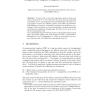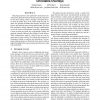351 search results - page 34 / 71 » Public-Key Cryptography and Availability |
EUROCRYPT
2006
Springer
13 years 11 months ago
2006
Springer
To prove that a secure key-agreement protocol exists one must at least show P = NP. Moreover any proof that the sequential composition of two non-adaptively secure pseudorandom fun...
CHES
2004
Springer
14 years 1 months ago
2004
Springer
In this paper we propose a new side channel attack, where exponent recodings for public key cryptosystems such as RSA and ECDSA are considered. The known side channel attacks and c...
NSDI
2007
13 years 10 months ago
2007
This paper proposes a new approach to anonymous communication called information slicing. Typically, anonymizers use onion routing, where a message is encrypted in layers with the...
FOCS
2010
IEEE
13 years 5 months ago
2010
IEEE
A fundamental question in leakage-resilient cryptography is: can leakage resilience always be amplified by parallel repetition? It is natural to expect that if we have a leakage-r...
CRYPTO
2005
Springer
14 years 1 months ago
2005
Springer
Abstract. We propose a way to establish peer-to-peer authenticated communications over an insecure channel by using an extra channel which can authenticate very short strings, e.g....


